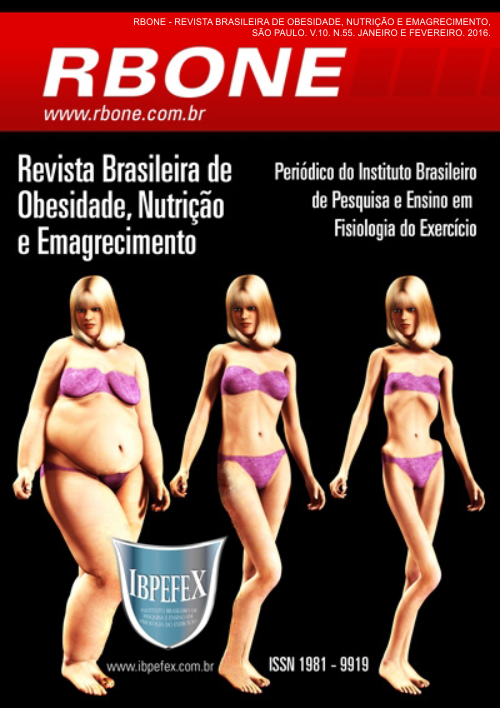Applicability of adiposity index body in estimate of body fat in male students
Abstract
The present study aimed to verify the level of applicability of the BAI, compared to other indirect techniques for assessing body composition (BMI and DC). The purposive sample consisted of 60 male children aged between 10 and 14 years. Weight and height to calculate BMI were collected. Verification of the %BF, the protocol Slaughter suggests that the sum of the Skin Folds (DC) of the triceps and medial calf (TR + PM) was used. The calculation was performed by dividing the BAI to measure the hip circumference (cm); the height (m) multiplied by the square root of the height (m), and 18 decreases the final result. For the statistical analysis we used the MedCalc software, where they calculated the descriptive statistics (Mean and SD), the normality test for determining the Spearman correlation degree and also the method of Bland Altman was performed to verify the degree of agreement between BMI, BAI and %BF with a significance level of p<0.05. We used the chi-square, to determine the association between the percentage frequencies in results between anthropometric methods. Significant correlations between BMI x %BF (r= 0.738; p <0.001) were found; BAI x BMI (r= 0.678; p<0.001) and between BAI x %BF (r= 0.687; p <0.001). It is possible to conclude that the IAC can not be and need to diagnose body fat in children 10-14 years of age a viable tool.
References
-Bergman, R.N.; Stefanovski, D.; Buchanan, T.A.; Sumner, A.E.; Reynolds, J.C.; Sebring, G.; Xiang, A.H.; Watanabe, R.M. A better index of body adiposity. Obesity Journal. Vol. 19. Num. 5. 2011. p. 1083-1089.
-Cioli, E.S.; Bernardes-Amorim, D.; Paiva Neto, A. Avaliação da composição corporal de atletas de natação brasileiros de alto nível. Coleção Pesquisa em Educação Física. Vol. 6. 2007.
-Dias, J.; Ávila, M.; Damasceno, V.O.; Gonçalves, R.; Barbosa, F.P.; Lamounier, J.A.; Vianna, J.M. Aplicabilidade do índice adiposidade corporal na estimativa do percentual de gordura de jovens mulheres brasileiras. Revista Brasileira de Medicina do Esporte. Vol. 20. Num. 1, 2014.
-Fernandes Filho, J. A prática da avaliação física: testes, medidas e avaliação física em escolares, atletas e academias de ginástica. Shape. 2003.
-Giugliano, R.; Carneiro, E.C. Fatores associados à obesidade em escolares. Jornal de Pediatria. Vol. 80. Num. 1. 2004.
-Gonçalves, R.; Mascarenhas, L.P.G.; Liebl, E.C.; Lima, V.A.; Souza, W.B.; Grzelczak, M.T.; Souza, W.C. Grau de concordância do IMC e do IAC com percentual de gordura corporal. Revista Brasileira de Qualidade de Vida. Vol. 6. Num. 1. 2014.
-Graciosa, M.D.; Coelho, J.J.; Costa, L.M.R.; Medeiros, D.L.; Martinello, M.; Ries, L.G.K. Effect of sedentary lifestyle, nutritional status and sex on the flexibility of students. Journal of Human Growth and Development. Vol. 23. Num. 2. 2013. p. 144-150.
-Heyward, V.H.; Gibson, A.L. Advanced fitness assessment and exercise prescription. Champaign, IL: Human Kinetics. 2010.
-Kuhn, P.C.; Vieira Filho, J.P.B.; Franco, L.; Fabbro, A.D.; Franco, L.J.; Moises, R.S. Evaluation of body adiposity index (BAI) to estimate percent body fat in an indigenous population. Clinical Nutrition. Vol. 33. 2014. p. 287-290.
-López, A.A.; e colaboradores. Body adiposity index utilization in a Spanish Mediterranean population: comparison.PloS one. Vol. 7. Num. 4. 2012. p. e35281.
-Pedroni, J.L.; Rech, R.R.; Halpern, R.; Marin, S.; Roth, L.R.; Sirtoli, M.; Cavalli, A. Prevalência de obesidade abdominal e excesso de gordura em escolares de uma cidade serrana no sul do Brasil. Ciência & Saúde Coletiva. Vol. 18. Num. 5. 2013. p.1417-1425. 12-Petroski, E.L. Antropometria: técnicas e padronizações. Fontoura.2011.13-Pollock, M.L.; Wilmore, J.H. Exercícios na saúde e na doença: avaliação e prescrição para prevençãoe reabilitação. Medsi.1993.14-Ribeiro, G.; Lopes, E.R.N.; Magalhães, J.C.; Andrade, M.A.S. Prevalência de sobrepeso e obesidade em crianças da rede pública de ensino da cidade de Cruz das Almas, Bahia. Revista Baiana de Saúde Pública. Vol. 37. Núm. 1. 2013. p. 9-19.15-Souza, W.C.; Mascarenhas, L.P.G.; Lima, V.A.; Souza, W.B.; Grzelczak, M.T.; Tajes Jr, D.; Bishop, J.E. Correlação entre o índice de adiposidade corporal (IAC) e índice de massa corporal (IMC) em atletas de futebol. In: III Seminário Integrado de Pesquisa, Ensino e Extensão.Anais... SIPEX.2013. resumo.16-Souza, W.C.; Mascarenhas, L.P.G.; Reiser, F.C.; Souza, W.B.; Lima, V.A.; Muniz, M.A.B.; Grzelczak, M.T. Relação entre o índice de adiposidade corporal, circunferência do pescoço e índice de massa corporal em mulheres sedentárias. Revista Brasileira de Obesidade, Nutrição e Emagrecimento.São Paulo.Vol. 8. Num. 48. 2014. p. 159-164a.17-Souza, W.C.; Mascarenhas, L.P.G.; Souza, W.B.; Grzelczak, M.T.; Lima, V.A.; Reiser, F.C. Associação entre o índice de adiposidade corporal (IAC) e índice de massa corporal (IMC) em mulheres praticantes de treinamento resistido. Revista Uniandrade. Vol. 15. Num. 1. 2014. p. 31-37b.18-Sulino, R.M.; Silva, A.P.; Ramos, L.E.; Silva, E.; Freitas, W.Z. Comparação entre o índice de adiposidade corporal e a avaliação da composição corporal através de medidas de dobras cutâneas. Coleção Pesquisa em Educação Física. Vol. 10. Num. 1. 2011. p. 63-68. 19-World Health Organization. Página visitada em10 de outubro de 2013. Disponível em: http://apps.who.int/bmi/index.jsp?introPage=intro_3.html
Authors who publish in this journal agree to the following terms:
- Authors retain the copyright and grant the journal the right of first publication, with work simultaneously licensed under the Creative Commons Attribution License BY-NC which allows the sharing of the work with acknowledgment of the authorship of the work and initial publication in this journal.
- Authors are authorized to enter into additional contracts separately for non-exclusive distribution of the version of the work published in this journal (eg, publishing in institutional repository or book chapter), with acknowledgment of authorship and initial publication in this journal.
- Authors are allowed and encouraged to post and distribute their work online (eg, in institutional repositories or on their personal page) at any point before or during the editorial process, as this can bring about productive change as well as increase impact and impact. citation of published work (See The Effect of Free Access).






